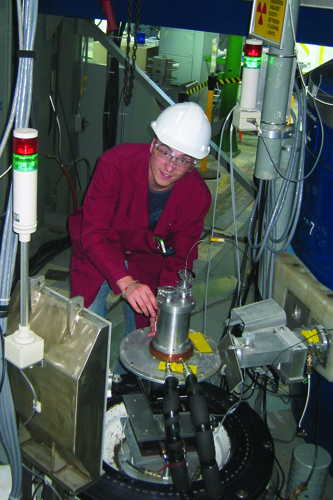
Respiratory distress syndrome (RDS) is a leading cause of death in babies up to one month old in the developed world because it makes breathing difficult. Researchers from Brock University use neutron beams to study biomolecules in the hope that it will lead to more effective treatments for RDS and other diseases, and to a molecular-level understanding of what vitamin E does in our bodies.
Source: Canadian Neutron Beam Centre (CNBC)
Contact: cnbc@cnl.ca
Before you can fix your car, you need to understand how it works. Similarly, understanding how your body works is fundamental to delivering better health care.
Your body is a complex system, with thousands of molecules in every cell performing different functions. In many cases, we still do not how they perform those functions, because they reside in or interact with cell membranes, an environment which is problematic to study with many common scientific techniques.
Professor Harroun of Brock University and his students use neutron beams to study these molecules, because neutron beams are effective yet gentle probes of delicate samples that require carefully controlled environments.
One such molecule is Vitamin E. Vitamin E is the only essential nutrient for which no one knows why it is essential, information that may be useful in optimising vitamin supplements. Vitamin E is also difficult to study in clinical trials because the effects of vitamin E only become apparent over long time scales.
Yet, using neutrons at the CNBC, the team was able to pin-point the location of vitamin E’s anti-oxidant activity at the interface of a model membrance with its aqueous environment. More significantly, their results point the direction toward more promising lines of research to unravel the mystery. They concluded that a significant body of research on vitamin E, that is, its oxidation kinetics and its products, needs to be revisited by taking into consideration the physical properties of the model membrane.
A second example of a molecule whose function is difficult to study without neutrons because it resides in membranes is a small protein called “KL4”. KL4 has been clinically proven to relieve respiratory distress syndrome in premature babies. Respiratory distress syndrome makes it difficult for affected babies to breathe and is a leading cause of death of babies up to one month old in the developed world. While it is known that KL4 helps to improve the exchange of oxygen with carbon dioxide in the lungs, it is not known how the protein does so. The team used neutron beams to study KL4 in the hope that understanding how it works will lead to more effective treatments for lung problems. The neutron beam experiments revealed the orientation of the KL4 alpha helix in a membrane chosen to mimic the conditions of lung surfactant studies.

Drew Marquardt sets up his experiment
on the N5 beamline
A third example of a difficult-to-study molecule is an anti-microbial agent, known as “chlorhexidine,” that is commonly used in personal hygiene products, such as soaps, contact lens solutions, and mouthwashes. Chlorhexidine disrupts bacterial membranes to kill the bacteria. Prof. Harroun’s research team is using the CNBC to test ideas about how the molecule works, as they move towards a patentable, membrane-based drug delivery system.
The fundamental importance of this research was recently recognised by NSERC when it awarded a 2012 Vanier Canada Graduate Scholarship to Drew Marquardt, who has been heavily involved in these three research projects. The Vanier scholarships are prestigious awards that aim to attract and retain the world’s top-tier doctoral students.
“My award is 100% connected to the CNBC,” said Drew, “not only because all my publications were enabled by access to the neutron beamlines, but also because neutron beams allow me to study potentially high-impact problems in biology.”
“CNBC has enabled me to study the functions of several key molecules in biology, including vitamin E, cholesterol, a small protein that treats lung problems, and an anti-bacterial agent. What all these have in common is that they perform their functions in cell membranes, an environment which is problematic for many other scientific techniques.”
